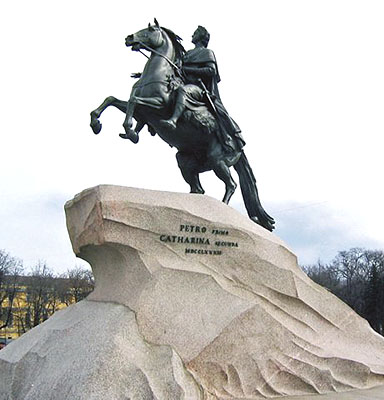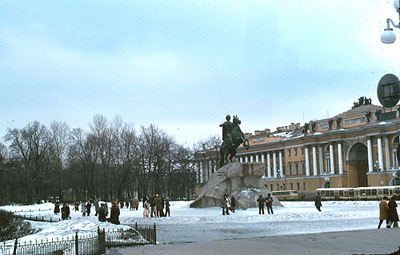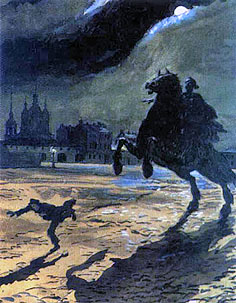

The pedestal is made of a single piece of red granite in the shape of a wave. (Some commentators call it a "cliff.) From the top, Peter shows the way to the West for Russia, while his horse steps on a snake, which represents the enemies of Peter and his reforms (or Sweden, the foe in the Great Northern War). The monument was built by order of Catherine the Great to make some connection to Peter (since she had absolutely none). The inscription on one side of the granite pedestal reads in Latin (Petro Primo Catarina Secunda 1782) and in Russian on the other side (ПЕТРУ перьвому ЕКАТЕРИНА вторая лѣта 1782.), "To Peter the First from Catherine the Second." The statue has three points of support (the two hind legs of the horse and the horse's tail); It is a really powerful monument.
According to legend, enemy forces would never capture St. Petersburg while the "Bronze Horseman" still stood as protector. During World War II the statute was protected with sand bags and a wooden shelter and survived intact. See also, Professor Blois' comments on Falconet and the Bronze Horseman.

Well, the statue is one thing, but you should always view the work in combination with another pillar of Russian culture, Aleksandr Pushkin's poem, The Bronze Horseman (Медный всадник) written in 1833, which is what really gave the sculpture its name "the Bronze Horseman. "In the poem, Pushkin described the fate of Evgenii and his loved ones during a flood of the Neva River. Pushkin used the image of the flood to show the conflict between the interests of the Russian state, represented by the Peter statue, and the immediate needs of the people for safety. The home of Evgenii's fiancée on one of the city's islands is washed away, and the inhabitants drowned. Evgenii, driven almost mad with grief, curses the Bronze Horseman statue. Suddenly, the statue breaks free from its pedestal and chases Evgenii to his death.

"Illustration of the Bronze Horseman breaking free from his pedestal to trample down Evgenii" by Alexandre Benois (Александр Бенуа, 1870–1960).
Benois was one of Russia's most important artists, a talented illustrator, set designer, art theorist and publicist. In 1897, he met Sergei Diaghilev and Leon Bakst who together joined forces to publish the art magazine, Mir iskusstva (world of art).